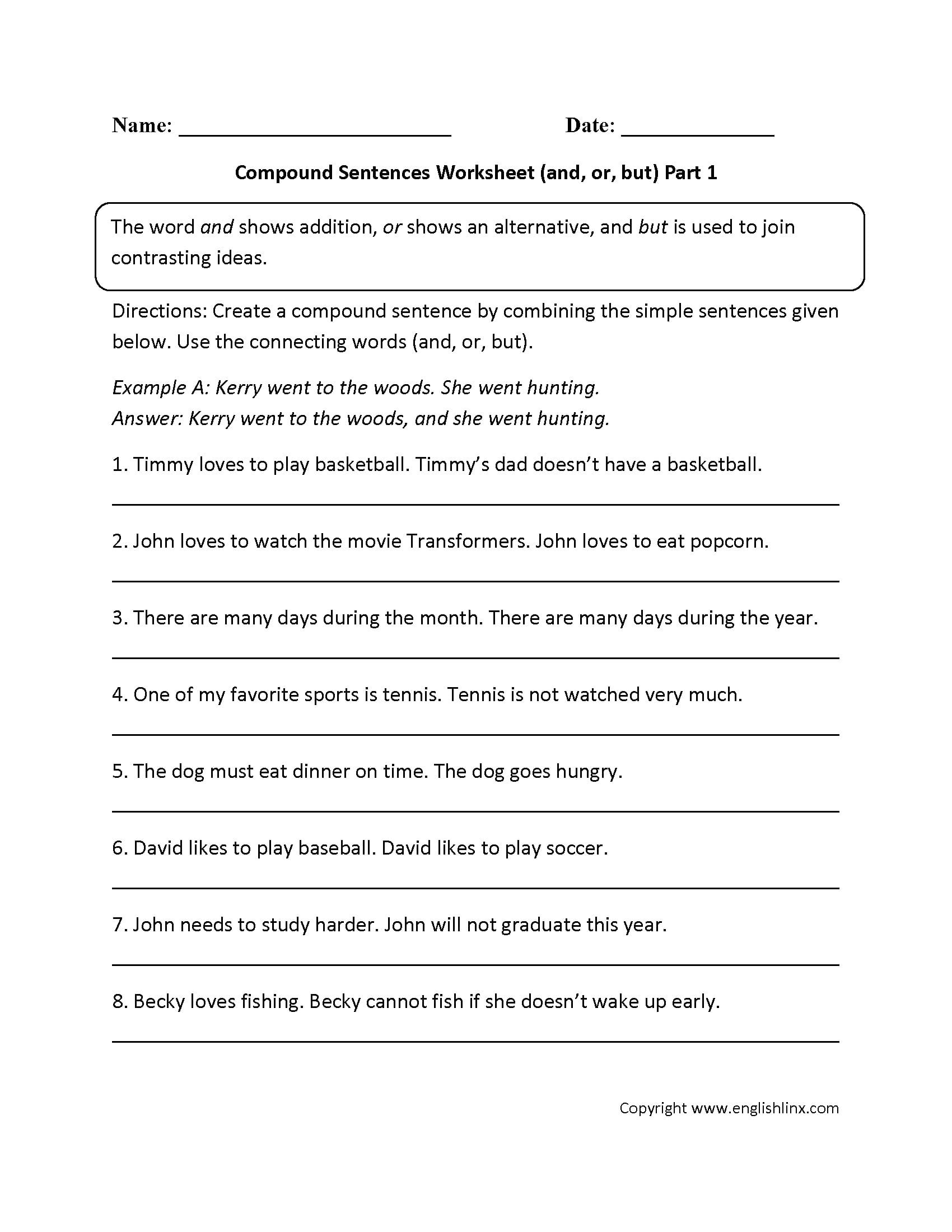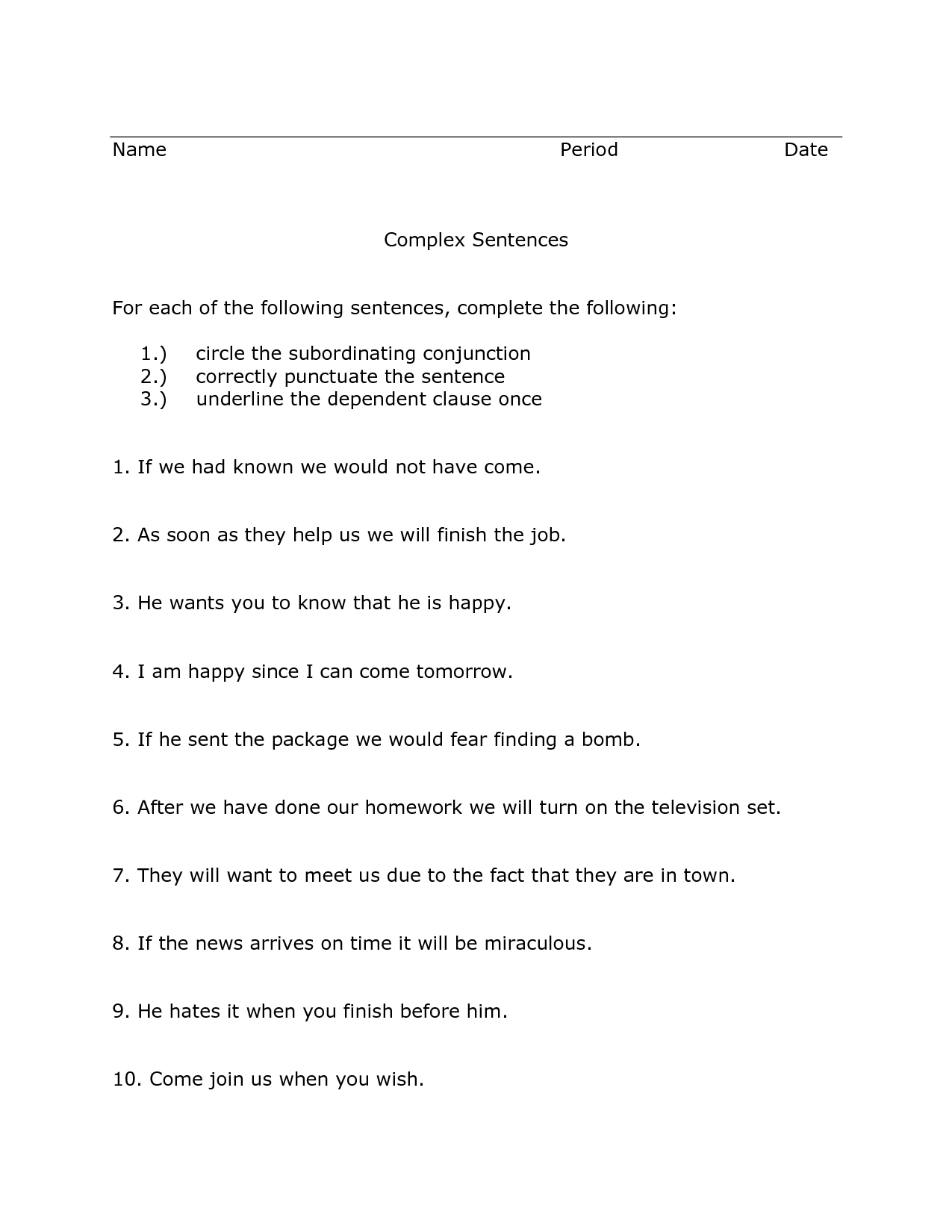Remember that thrilling moment in elementary school when you finally grasped the difference between a noun and a verb? It felt like unlocking a secret code, right? Learning to construct grammatically correct sentences was another exciting milestone. But what about those sentences that seemed to stretch out forever, with multiple clauses and conjunctions? That’s where the magic of simple, complex, and compound sentences comes in. As a writer, crafting these different sentence structures has always fascinated me. It’s a bit like juggling—keeping track of subject-verb agreement, punctuation, and the flow of ideas. And just like a skilled juggler, mastering these sentence structures can elevate your writing from ordinary to extraordinary.

Image: db-excel.com
Today, we embark on a journey to conquer the world of simple, complex, and compound sentences by exploring a common tool for learning: worksheets. So grab a pen, your trusty notebook, and your favorite beverage, as we delve into the answers to those pesky worksheets, boosting your confidence in sentence construction and empowering you to express yourself with clarity and style.
Unveiling the Secrets of Sentence Structures
Think of sentences as the building blocks of language. Just as the humble brick forms the foundation of a magnificent structure, sentences provide the framework for our thoughts and ideas. But like bricks, sentences come in various shapes and sizes, each with its unique purpose and effect. Let’s break down the three main sentence types:
Simple Sentences: The Foundation
Simple sentences are the most basic type. They contain a single independent clause, which means they have a subject and a verb and express a complete thought. For example, “The dog barked,” is a simple sentence. It has the subject “dog” and the verb “barked” and conveys a complete thought.
Complex Sentences: Adding Depth
Complex sentences take things up a notch. They contain one independent clause and at least one dependent clause. A dependent clause, also known as a subordinate clause, can’t stand alone as a complete sentence and needs an independent clause to create a complete thought. These clauses are connected by subordinating conjunctions like “because,” “although,” “while,” “since,” etc. For instance, “The dog barked because the mailman arrived” is a complex sentence. The independent clause is “The dog barked,” and the dependent clause is “because the mailman arrived.”

Image: www.worksheeto.com
Compound Sentences: Joining Forces
Compound sentences combine two or more independent clauses, each capable of standing alone as a complete sentence. These clauses are joined by coordinating conjunctions like “and,” “but,” “or,” “so,” “for,” or “yet.” For example, “The dog barked, and the mailman ran” is a compound sentence. Each clause “The dog barked” and “the mailman ran” is a complete thought, and they are connected by the coordinating conjunction “and.”
Decoding the Worksheet Answers: A Step-by-Step Guide
Now, let’s dive into the exciting realm of worksheets and their answers. The purpose of a simple, complex, compound sentences worksheet is to solidify your understanding of these sentence structures and allow you to practice identifying and constructing them. These worksheets often present a list of sentences, asking you to categorize them into simple, complex, and compound. You might also be tasked with combining sentences into different structures or even creating your own examples.
To tackle those worksheet answers confidently, follow these steps:
- Identify the clauses: Begin by reading each sentence and pinpointing the independent and dependent clauses. Ask yourself: Does this clause express a complete thought on its own? If yes, it’s an independent clause. If it relies on another clause to make sense, it’s a dependent clause.
- Look for conjunctions: Pay close attention to the conjunctions used in the sentence. Subordinating conjunctions like “because,” “although,” “while,” “since,” etc., mark a dependent clause. Coordinating conjunctions like “and,” “but,” “or,” “so,” “for,” or “yet,” indicate independent clauses joined to form a compound sentence.
- Categorize the sentence: Based on the presence of independent and dependent clauses and the type of conjunction, you can easily classify the sentence as simple, complex, or compound.
- Practice, practice, practice: The key to mastering any skill is practice. Don’t be afraid to revisit those worksheets and reinforce your understanding. The more you practice, the more confident you’ll become.
Tips and Expert Advice
As your writing journey progresses, using a mix of simple, complex, and compound sentences can add variety and impact to your work. Here are some valuable tips for enhancing your sentence construction:
- Vary your sentence length: Combining short, impactful sentences with longer, more intricate ones keeps your writing engaging. Too many short sentences can feel choppy, while overly long sentences can be difficult to follow.
- Use punctuation effectively: Commas, semicolons, and periods play a crucial role in properly structuring sentences and guiding the reader through your train of thought. Pay close attention to proper punctuation rules to ensure clarity and coherence in your writing.
- Consider your audience: Adapt your sentence structure to suit your audience’s comprehension level and the intended tone of your writing. Complex sentences can be helpful for conveying nuanced ideas, while simple sentences might be better for conveying information clearly and concisely.
Remember, mastering sentence structure isn’t just about following rules; it’s about understanding how different structures can achieve different effects. Experiment with varying your sentence construction to find what works best for your writing style and for effectively conveying your message.
FAQs about Simple, Complex, and Compound Sentences
Here are some frequently asked questions about these sentence structures:
Q: Can a sentence be both complex and compound?
A: Absolutely! A sentence can contain both independent and dependent clauses, making it both complex and compound. For example, “The dog barked because the mailman arrived, but he didn’t chase him.” This sentence contains two independent clauses (“The dog barked” and “he didn’t chase him”) and one dependent clause (“because the mailman arrived”).
Q: Does the order of clauses matter?
A: In complex sentences, the order of clauses can influence the emphasis of the sentence. Placing the dependent clause before the independent clause emphasizes the subordinate information, while placing it after the independent clause highlights the main idea.
Q: How many clauses can a compound sentence have?
A: A compound sentence can have as many independent clauses as needed, as long as they are properly joined by coordinating conjunctions. However, keep in mind that excessively long compound sentences can become cumbersome to read.
Q: What’s the difference between a clause and a phrase?
A: A clause contains both a subject and a verb, while a phrase does not. A phrase is a group of words that functions as a single unit, but it doesn’t contain a subject and a verb that can stand alone as a complete thought. For instance, “into the night” is a phrase because it lacks a subject and a verb, whereas “when the night came” is a clause because it has both a subject (“night”) and a verb (“came”).
Simple Complex Compound Sentences Worksheet Answers
Continuing the Journey
Well, there you have it! We’ve delved into the world of simple, complex, and compound sentences, uncovered the secrets of worksheet answers, and even explored some expert tips. Remember, mastering these sentence structures is an ongoing journey, not a destination. Practice makes perfect! Keep exploring, experimenting, and honing your writing skills, and you’ll be crafting sentences that captivate your readers and leave a lasting impression.
Are you interested in exploring more about sentence structure? What other topics in grammar or writing would you like to delve into? Share your thoughts and questions in the comments below!




